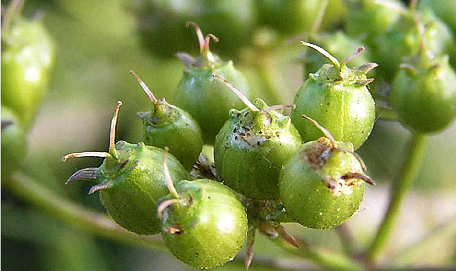Stability analysis for grain yield of coriander (Coriandrum sativum L.) genotypes in Bale, South-East Ethiopia
Keywords:
AMMI, ASV, Yield, Biplot, Genotypes, GxE interaction, PCAAbstract
Yield data of 10 coriander (Coriandrum sativum L.) genotypes tested across 9 rain-fed environments during the 2014-2016 growing season using RCBD in 3 replications were analyzed using the AMMI model. The AMMI analysis tested in nine environments (years) were showed that the yield was significantly affected (P<0.001) by genotypes and environment main effects as well as GxE interaction. The model revealed that differences between the environments accounted for about 58.16% of the treatment sum of squares. The genotypes and the GxE interaction also accounted significantly for 12.79 % and 29.05% respectively of the treatment SS. The first principal component axis (PCA1) of the interaction captured 41.97% of the interaction sum of squares. Similarly, the second principal component axis (PCA2) explained a further 39.05% of the GEI sum of squares. The mean squares for the PCA1 and PCA2 were significant at P=0.01 and cumulatively contributed to 81.02% of the GxE interaction SS, leaving 18.98% of the variation in the GxE interaction in the residual. The AMMI and AMMI stability value (ASV) identified G8 and G3 as the stable and high yielding genotypes. Therefore, release of these genotypes for production in the mid and lowlands of Bale will result in increased production and productivity of coriander in the country.References
Crossa, J., 1990. Statistical analysis of multilocation trials. Adv. Agron., 44, 55-85.
Ebdon, J.S., Gauch, H.G., 2002a. Additive main effect and multiplicative interaction analysis of national turfgrass performance trials: I. Interpretation of genotype x environment interaction. Crop. Sci., 42, 489-496.
Gauch, H.G., 1988. Model selection and validation for yield trials with interaction. Biometrics, 44, 705-715.
Gauch, H.G., 2006. Statistical analysis of yield trials by AMMI and GGE. Crop. Sci., 46, 1488-1500.
Gauch, H.G., Zobel, R.W., 1990. Imputing missing yield trial data. Theor. Appl. Genet., 79, 753-761.
Holhs, T., 1995. Analysis of genotype environment interactions. S. Afr. J. Sci., 91, 121-124.
Lin, C.S., Binns, M.R., 1988b. A method of analyzing cultivar × location 10 year experiments: A new stability parameter. Theor. Appl. Genet., 76, 425-430.
Mohammadi, R., Amri, A., 2008. Comparison of parametric and non-parametric methods for selecting stable and adapted durum wheat genotypes in variable environments. Euphytica, 159, 419-432.
Mohammadi, R., Roostaei, M., Ansari, Y., Amri, A., 2010. Relationships of phenotypic stability measures for genotypes of three cereal crops. Can. J. Plant Sci., 90, 819-830.
Samonte, S.O.P.B., Wilson, L.T., McClung, A.M., Medley, J.C., 2005. Targeting cultivars onto rice growing environments using AMMI and SREG GGE biplot analysis. Crop. Sci., 45, 2414-2424.
Yan, W., Hunt, L.A., Sheng, Q., Szlavnics, Z., 2000. Cultivar evaluation and mega-environment investigation based on the GGE biplot. Crop. Sci., 40, 597-605.
Zobel, R.W., Wright, M.S., Gauch, H.G., 1988. Statistical analysis of a yield trial. Agron. J., 80, 388-393.

Published
How to Cite
Issue
Section
Copyright (c) 2020 Mohammed Beriso, Getachew Asefa

This work is licensed under a Creative Commons Attribution-NonCommercial-NoDerivatives 4.0 International License.



